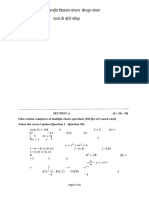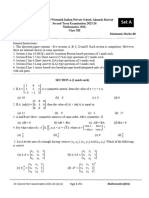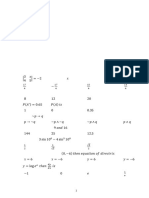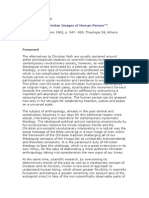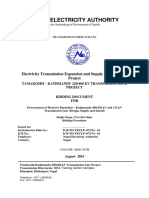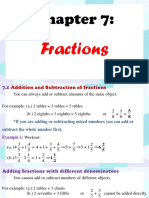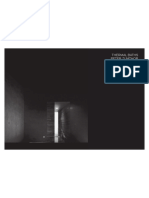D.J. Science College - XI Mathematics Prelim Paper-1
D.J. Science College - XI Mathematics Prelim Paper-1
Uploaded by
muhammedanaskhan1767890Copyright:
Available Formats
D.J. Science College - XI Mathematics Prelim Paper-1
D.J. Science College - XI Mathematics Prelim Paper-1
Uploaded by
muhammedanaskhan1767890Copyright
Available Formats
Share this document
Did you find this document useful?
Is this content inappropriate?
Copyright:
Available Formats
D.J. Science College - XI Mathematics Prelim Paper-1
D.J. Science College - XI Mathematics Prelim Paper-1
Uploaded by
muhammedanaskhan1767890Copyright:
Available Formats
DJ Sindh Govt.
Science College, Karachi
Preliminary Examination 2024
Mathematics – I
For Science Pre-Engineering & Science General Groups
Time allowed: 3 hours Maximum Marks: 100
SECTION ‘A’ (MULTIPLE CHOICE QUESTIONS) – (M.C.Qs.)
Time allowed: 20 minutes (Marks : 20)
NOTE: (i). This section consists of 20 part questions and all are to be answered. Each question carries one mark.
(ii). The correct answer bubble must be filled on OMR sheet (I) Ⓐ Ⓑ Ⓒ Ⓓ pasted in answer script.
(iii). Use only blue / black ball point pen or pointer on OMR sheet.
(iv). Avoid using pencil / White-o pen on OMR sheet.
(v). All notations are used in their usual meanings. The use of Scientific Calculator is allowed.
Q. 1. Choose the correct answer for each from the given options.
1. |𝑥 + 5𝑖| = 3 then 𝑥 is equal to:
(a) ±4 (b) ±4𝑖 (c) ±22𝑖 (d) None of these.
2
2. (1+𝑖
1−𝑖
) = _________________
(a) −1 (b) 1 (c) 𝑖 (d) −𝑖
3. A square matrix 𝐴 = [𝑎𝑖𝑗 ] for which all 𝑎𝑖𝑗 = 0, 𝑖 < 𝑗 then A is called:
(a) Upper triangular (b) Lower triangular (c) Symmetric (d) Hermitian
4. The number of non-zero rows in echelon form of a matrix is:
(a) Order (b) Rank (c) Leading Row (d) Leading Column
1 2 4
5. The cofactor 𝐴22 of [−1 2 5 ] is:
0 1 −1
(a) 0 (b) −1 (c) 1 (d) 2
6. If |𝑎⃗ × 𝑏⃗⃗| = |𝑎⃗ . 𝑏⃗⃗| then the angle between 𝑎⃗ and 𝑏⃗⃗ is:
𝜋 𝜋
(a) 0 (b) 2 (c) 4 (d) 𝜋
7. The number of vectors of unit length perpendicular to the plane of vectors 𝑎⃗ = 2𝑖̂ + 𝑗̂ + 2𝑘̂ and 𝑏⃗⃗ = 𝑗̂ + 𝑘̂ is:
(a) One (b) Two (c) Three (d) Infinite
8. The sum of infinite geometric series is a finite number if:
(a) |𝑟| > 1 (b) |𝑟| = 1 (c) |𝑟| ≥ 1 (d) |𝑟| < 1
9. If 𝑎−𝑏 𝑎
= 𝑏 then 𝑎, 𝑏 and 𝑐 are in:
𝑏−𝑐
(a) A.P (b) G.P (c) H.P (d) None of These
10. ∑20 0
𝑛=3 𝑛 = _____________:
(a) 1 (b) 19 (c) 20 (d) 18
11. Two teams A and B are playing a match, the probability that team A does not loose is:
1 2 1
(a) (b) (c) 2 (d) 0
3 3
1
12. The number of terms in the expansion of(1 + 𝑥)3 is:
4
(a) (b) 4 (c) ∞ (d) 2
3
13. The expansion of (1 − 2𝑥)−2 is valid if:
1
(a) |𝑥| < 0 (b) |𝑥| < 2 (c) |𝑥| < 2 (d) |𝑥| < 1
14. The graph of 𝑦 = 𝑥 𝑛 is symmetric to _________ if 𝑛 is an odd integer.
(a) 𝑥 − 𝑎𝑥𝑖𝑠 (c) 𝑦 − 𝑎𝑥𝑖𝑠 (c) 𝑂𝑟𝑖𝑔𝑖𝑛 (d) 𝑁𝑜𝑛𝑒
15. A point of a solution region region where two of its boundary lines intersect is called_______.
(a) Middle point (b) Origin (c) Corner point (d) Feasible point
16. 2sin 7𝜃 sin 2𝜃 is equal to:
(a) cos 5𝜃 − cos 9𝜃 (b) cos 9𝜃 − cos 5𝜃
(c) sin 9𝜃 + sin 5𝜃 (d) sin 9𝜃 − sin 5𝜃
17. cos 2𝜃 is equal to:
(a) cos 2 𝜃 − sin2 𝜃 (b) 2 cos 2 𝜃 − 1(c) 1 − 2 sin2 𝜃 (d) all of these
18. Circum radius of ∆𝐴𝐵𝐶 is:
∆ ∆ ∆ 𝑎𝑏𝑐
(a) (c) 𝑆−𝑏 (c) 𝑆−𝑎 (d)
𝑆 4∆
19. Inverse function exists if and only if the function is:
(a) Bijective (b) One-to-One (c) Onto (d) Into
20. tan−1(−𝑥) = _____________.
(a) − tan−1 𝑥 (b) 𝜋 − tan−1 𝑥 (c) cot −1 𝑥 (d) tan−1 𝑥
DJ Sindh Govt. Science College, Karachi
Preliminary Examination 2024
Mathematics – I
For Science Pre-Engineering & Science General Groups
Time allowed: 2 hours and 40 minutes Maximum Marks: 80
NOTE: (i). Attempt any ten parts from Section ‘B’ and any five questions from Section ‘C’.
SECTION ‘B’ (SHORT-ANSWER QUESTIONS) (Marks : 40)
NOTE: Answer Any ten parts of the questions from this section. All questions carry equal marks.
Q.No. 2
3𝑖−2 −2
(i). Find the real and imaginary part of (2−3𝑖) by using any method.
4 6 8
(ii). Find the adjoint of the matrix 𝐴 = [1 3 2]. ,
2 7 5
1 𝑎 𝑏+𝑐
(iii). Without expanding determinant, prove that |1 𝑏 𝑐 + 𝑎 | = 0.
1 𝑐 𝑎+𝑏
(iv). Find a unit vector perpendicular to each of vector 𝑎⃗ + 𝑏⃗⃗ and 𝑎⃗ − 𝑏⃗⃗ where; 𝑎⃗ = 3𝑖̂ + 5𝑗̂ + 𝑘̂ and 𝑏⃗⃗ = 𝑖̂ + 2𝑗̂ − 5𝑘̂.
(v). Find three consecutive terms in G.P. whose sum is 39 and their product is 729.
(vi). Find the sum of first forty-six natural numbers starting from the 10.
(vii). How many diagonals and triangles can be drawn in a plane by joining the vertices of an octagon?
(viii). Prove that 7𝑛 − 4𝑛 is divisible by 3, using mathematical induction.
(ix). The coefficient of the fifth, sixth and seventh terms of the expansion (1 + 𝑥)𝑛 form an A.P. Find 𝑛.
𝑥−1
(x). Find the inverse of 𝑓 and determine the domain and range of 𝑓 −1 for the real valued function 𝑓(𝑥) = 𝑥−3 , 𝑥 ≠ 3.
(xi). Find the equation of the graph of the function of the type 𝑦 = 3𝑥 2 + 𝑏𝑥 + 𝑐 which crosses the x-axis at the
points (−4, 0) and (5, 0).
(xii). If 𝐴 + 𝐵 + 𝐶 = 180𝑜 than prove that:
tan 𝐴 + tan 𝐵 + tan 𝐶 = tan 𝐴 tan 𝐵 tan 𝐶
(xiii). Find the smallest angle in Δ𝐴𝐵𝐶, when:
𝑎 = 25𝑐𝑚, 𝑏 = 18𝑐𝑚 and 𝑐 = 21𝑐𝑚
(xiv). Two hikers start from the same point; one walks 9km heading east, the other one 10 km heading 55𝑜 northeast.
How far apart are they at the end of their walks?
(xv). By using properties of graph of cosine, show that; cos(2𝜋 + 𝜃) = cos 𝜃.
OR
Show that: sin(cos −1 𝑦) = √1 − 𝑦 2 .
SECTION ‘C’ (DETAILED-ANSWER QUESTIONS) (Marks : 40)
NOTE: Answer any Five questions from this section. Question 3 is compulsory. All questions carry equal marks. (i. e. 8
marks of each question).
3. Use Gauss-Jordan method to solve the system of linear equations:
𝑥 − 𝑦 + 4𝑧 = 4
2𝑥 + 2𝑦 − 𝑧 = 2
3𝑥 − 2𝑦 + 3𝑧 = −3
𝑥 𝑛−5 +𝑦𝑛−5
4. Find 𝑛 so that 𝑥 𝑛−6 +𝑦𝑛−6 may be H.M between 𝑥 and 𝑦.
5. A marble is drawn at random from a box containing 20 red, 10 white, 25 orange and 15 blue marbles. Find the
probability that it is:
(i) orange or red (ii) not blue or red (iii) red, white or blue
1 2 1.3 2 2 1.3.5 2 3
6. If 𝑥 = 5 + (5) + (5) + ⋯, then use binomial theorem to show that: 4𝑥 2 − 20𝑥 − 1 = 0.
2! 3!
⃗⃗⃗⃗⃗⃗ and 𝑌 divides 𝐵𝐶
7. In a parallelogram 𝐴𝐵𝐶𝐷, 𝑋 is the midpoint of 𝐴𝐵 ⃗⃗⃗⃗⃗⃗ in 1: 2. Show that if 𝑍 divides 𝐷𝑋
⃗⃗⃗⃗⃗⃗ in 6: 1 then
⃗⃗⃗⃗⃗⃗ in 3: 4.
it also divides 𝐴𝑌
8. A toy factory manufactures two types of toys A and B and sells for Rs.25 and Rs. 20 respectively. The toys A and B
respectively, require 20 units and 12 units daily out of 2000 available resources units. Both require a production
time of 5 minutes and total working hours are 9 per day. What should be quantity for each of the toys to maximize
the selling amount?
9. Find general solution of trigonometric equation: sin 4𝜃 − sin 2𝜃 = cos 3𝜃 and verify the solution.
10. Use trigonometric formulae to prove that:
sin 2𝜃 + sin 4𝜃 + sin 6𝜃 + sin 8𝜃
= tan 5𝜃
cos 2𝜃 + cos 4𝜃 + cos 6𝜃 + cos 8𝜃
You might also like
- AIA Layer StandardsDocument47 pagesAIA Layer StandardsseptiNo ratings yet
- Asia International Mathematical Olympiad Union: Senior SecondaryDocument4 pagesAsia International Mathematical Olympiad Union: Senior SecondaryNguyen MinhThanh100% (1)
- QP MATH SET2Document6 pagesQP MATH SET2Dileep ShuklaNo ratings yet
- S6 - Mathematics - Half Yearly - 23Document8 pagesS6 - Mathematics - Half Yearly - 23aladdinvszafar100% (1)
- Class XII Set - 1 DAV Pre-Board Mathematics QPDocument9 pagesClass XII Set - 1 DAV Pre-Board Mathematics QPlucky20080802No ratings yet
- 1st PU Midterm QP OCT24Document3 pages1st PU Midterm QP OCT24altkekw012No ratings yet
- Question PaperDocument6 pagesQuestion Papertonsirai07No ratings yet
- Half Yearly (Xii) 2022Document8 pagesHalf Yearly (Xii) 2022captainunknown28No ratings yet
- Sample Paper 1 ImsDocument5 pagesSample Paper 1 ImsHARDIK SharmaNo ratings yet
- Mathematics Minor Test 5Document10 pagesMathematics Minor Test 5Ammar YasirNo ratings yet
- 12 Term 2 QP Set A 2023-24 - 1Document6 pages12 Term 2 QP Set A 2023-24 - 1moiiifitbituserNo ratings yet
- Mathematics 10 Model Papers 24Document34 pagesMathematics 10 Model Papers 24VIKRAMNo ratings yet
- KVS Lucknow XII MATH QP & MS Pre-Board (23-24)Document13 pagesKVS Lucknow XII MATH QP & MS Pre-Board (23-24)mvharshini2006No ratings yet
- HSSC-II Math Final PackageDocument11 pagesHSSC-II Math Final Packagesyedali822019No ratings yet
- 3p 10th Maths WTS ModelDocument3 pages3p 10th Maths WTS Modelmagishtimes sivaNo ratings yet
- FinalDocument7 pagesFinalEssam ElkholyNo ratings yet
- Class 11 Maths HyDocument4 pagesClass 11 Maths HyIshuNo ratings yet
- 35 Mathematics QpDocument15 pages35 Mathematics QplavanyahsnaikNo ratings yet
- Sem 1-IX - MathsDocument6 pagesSem 1-IX - MathsDevika ArulNo ratings yet
- Sample PaperDocument120 pagesSample PaperDinesh SamantarayNo ratings yet
- Ist Preboard MATHS 12TH22-23Document4 pagesIst Preboard MATHS 12TH22-23Aayushman KathayatNo ratings yet
- XI Maths QPDocument5 pagesXI Maths QPPriyanshu BadhiaNo ratings yet
- Grade XII Term I -App Math sample paperDocument7 pagesGrade XII Term I -App Math sample paperKrishiv MalkaniNo ratings yet
- MTH - 12 - CH 4 5 6 7Document1 pageMTH - 12 - CH 4 5 6 7eastitechNo ratings yet
- Maths QP 1Document5 pagesMaths QP 1coolgameryt89No ratings yet
- Mathematics Qp - Set 2Document8 pagesMathematics Qp - Set 2Ashwin RainaNo ratings yet
- XII MATHS-041 QP Set-ADocument6 pagesXII MATHS-041 QP Set-Amathflix313No ratings yet
- 12M SriramDocument8 pages12M Sriramriddhim.254.2024No ratings yet
- REV SHEET QP IXDocument6 pagesREV SHEET QP IXRajani SakhraniNo ratings yet
- Math 1st YearDocument3 pagesMath 1st Yearizaz gulNo ratings yet
- Class 10 Maths DvpsDocument5 pagesClass 10 Maths Dvpsramansharma9759No ratings yet
- 12 Mat QP 20112024Document5 pages12 Mat QP 20112024priyanshusolanky670No ratings yet
- Calculus I Model QuestionsDocument3 pagesCalculus I Model QuestionsmolgoanerNo ratings yet
- Grade 10 Mathematics WorksheetDocument30 pagesGrade 10 Mathematics Worksheetabdellamohammed724No ratings yet
- 12PB24MAT03 QPDocument8 pages12PB24MAT03 QPpraths710No ratings yet
- XII MathsDocument8 pagesXII Mathsrefrigerater0No ratings yet
- 12 Model Set A 2023-24Document7 pages12 Model Set A 2023-24moiiifitbituserNo ratings yet
- Session Ending Exam 2023-24: Which of The Following Is Not Equal To Cos 2Document5 pagesSession Ending Exam 2023-24: Which of The Following Is Not Equal To Cos 2arihantraj499No ratings yet
- Maths PaperDocument4 pagesMaths Paperkrishnaghodke03No ratings yet
- Xii A, B Maths QSN PPR Term 1 2024Document4 pagesXii A, B Maths QSN PPR Term 1 2024ᴘᴀᴠᴀɴNo ratings yet
- Sample Paper-1 Class: Xii Sub: Mathematics (041) Time Allowed: 3 Hours Maximum Marks: 80 General InstructionsDocument21 pagesSample Paper-1 Class: Xii Sub: Mathematics (041) Time Allowed: 3 Hours Maximum Marks: 80 General Instructionslaleko1077No ratings yet
- Ix Revision For PT-1Document3 pagesIx Revision For PT-1Hafiz ShemeerNo ratings yet
- Grade 7Document8 pagesGrade 7Bentley Leopold HalimNo ratings yet
- Lahore Garrison School & Academy: MathematicsDocument2 pagesLahore Garrison School & Academy: Mathematics11el1010% (1)
- 12pb24mat02 QPDocument7 pages12pb24mat02 QPpriyanshusolanky670No ratings yet
- Sample Xi AnnualDocument5 pagesSample Xi AnnualSHAURYA SINGHNo ratings yet
- NIMCET 2009 Mca Entrance Cuet Du Mca Previous Year Paper For PracticeDocument29 pagesNIMCET 2009 Mca Entrance Cuet Du Mca Previous Year Paper For PracticeArpit DhimanNo ratings yet
- 11 Mathematics sp02-1-7Document7 pages11 Mathematics sp02-1-7comproject356No ratings yet
- S.Q.P-1-1 (1)Document14 pagesS.Q.P-1-1 (1)raghavkhatri72No ratings yet
- LSS T3 (Enregistré Automatiquement)Document4 pagesLSS T3 (Enregistré Automatiquement)corellemegaptcheNo ratings yet
- NEB General QuestionDocument3 pagesNEB General QuestionPuskar BistNo ratings yet
- Maths Practice Paper - Answer Key (Stepwise Solutions) - 2021 - 22 PDFDocument17 pagesMaths Practice Paper - Answer Key (Stepwise Solutions) - 2021 - 22 PDFDhwani ShahNo ratings yet
- XI Maths Guess Paper 2024Document15 pagesXI Maths Guess Paper 2024techbrohi828No ratings yet
- XI Maths UT-1 KVSTPDocument2 pagesXI Maths UT-1 KVSTPlakhanpal747No ratings yet
- Category VDocument11 pagesCategory VDavid AnNo ratings yet
- 75 Basic Maths MQP 3Document4 pages75 Basic Maths MQP 3guestff0000010No ratings yet
- 75 Basic Maths MQP 1Document4 pages75 Basic Maths MQP 1gaganadishwar13No ratings yet
- Aryabhatta Question Paper Class XI 2019Document15 pagesAryabhatta Question Paper Class XI 2019Amisha BariNo ratings yet
- BASIC MATHEMATICS Question PaperDocument3 pagesBASIC MATHEMATICS Question Papermdasiff260No ratings yet
- Class Xii Maths (Student Support Material 2024-25)Document70 pagesClass Xii Maths (Student Support Material 2024-25)himnishsharma100No ratings yet
- Top 100 Networking Interview QuestionsDocument26 pagesTop 100 Networking Interview Questionsnagaraj100% (1)
- Takdang Aralin Sa Araling Panlipunan Rizzan Murillo 1Document5 pagesTakdang Aralin Sa Araling Panlipunan Rizzan Murillo 1Haydee DionaldoNo ratings yet
- Sorbom, Dag (1974)Document11 pagesSorbom, Dag (1974)evgtsNo ratings yet
- Tips and Tricks While Having Your Child at Home: By: Audrey WhitfieldDocument6 pagesTips and Tricks While Having Your Child at Home: By: Audrey WhitfieldMeral SalihiNo ratings yet
- Claude Zephrix C. Ariston: EducationDocument2 pagesClaude Zephrix C. Ariston: EducationKangNo ratings yet
- VU-Assignment MCM-301Document2 pagesVU-Assignment MCM-301mc220203866 JAWAD SARWARNo ratings yet
- 1.3 Lesson Plan Transcoding Graphics (2 HR) PDFDocument8 pages1.3 Lesson Plan Transcoding Graphics (2 HR) PDFAbirami VetrivelNo ratings yet
- Apni Kaksha: (Cos) + (Sin) Cos SinDocument3 pagesApni Kaksha: (Cos) + (Sin) Cos Sinhimanshu PANGARIYANo ratings yet
- Nikos A. Nissiotis "Secular and Christian Images of Human Person"Document74 pagesNikos A. Nissiotis "Secular and Christian Images of Human Person"Garland Haney100% (1)
- Logical Facts and OpinionDocument2 pagesLogical Facts and OpinionHalimatNo ratings yet
- Vol-II (B) EditedDocument125 pagesVol-II (B) EditedtanujaayerNo ratings yet
- Modeling of Electrical and Mechanical Systems: Lectures 12-15Document87 pagesModeling of Electrical and Mechanical Systems: Lectures 12-15blzz2netNo ratings yet
- Book 2 - Chapter 7 FractionsDocument25 pagesBook 2 - Chapter 7 FractionsJMGNo ratings yet
- Models of CommunicationDocument22 pagesModels of CommunicationHannah Faith TablatinNo ratings yet
- Stiffened RoundDocument16 pagesStiffened RoundIoannis Mitsis100% (1)
- Agenda - TAJ GAVEL CLUB - Meeting 16Document1 pageAgenda - TAJ GAVEL CLUB - Meeting 16Ahmed ZidanNo ratings yet
- Bug ReportDocument31 pagesBug ReportLuaré RodanteNo ratings yet
- Carry Out Measurements and CalculationsDocument2 pagesCarry Out Measurements and CalculationsRAMON ENRIQUEZ HIGH SCHOOL67% (3)
- Doctoral Thesis: Advanced Techniques For Seismic Vibration ControlDocument4 pagesDoctoral Thesis: Advanced Techniques For Seismic Vibration ControlGanesh KumarNo ratings yet
- VISIT BODØ - An All Year Round DestinationDocument11 pagesVISIT BODØ - An All Year Round Destinationviktor4555No ratings yet
- 1ST Term Exam 2023-2024Document10 pages1ST Term Exam 2023-2024isahjibrilkev6No ratings yet
- Mgt. ConsultancyDocument491 pagesMgt. Consultancydilshanip100% (3)
- CRJ270 Chapter1Document44 pagesCRJ270 Chapter1Lester Alvin AndalNo ratings yet
- Probability CalculatorDocument151 pagesProbability CalculatorsatinndersikriNo ratings yet
- Tolerance Charts: Dr. Pulak M. PandeyDocument38 pagesTolerance Charts: Dr. Pulak M. PandeyParthi ParthipanNo ratings yet
- Chris Aubeck - Desperately Seeking RudolphDocument16 pagesChris Aubeck - Desperately Seeking RudolphPeon100% (2)
- The Jaw Functional Limitation Scale: Development, Reliability, and Validity of 8-Item and 20-Item VersionsDocument12 pagesThe Jaw Functional Limitation Scale: Development, Reliability, and Validity of 8-Item and 20-Item VersionsAkilesh RamasamyNo ratings yet
- Zumthor Thermal Baths PDFDocument6 pagesZumthor Thermal Baths PDFAndreea Pîrvu100% (1)






